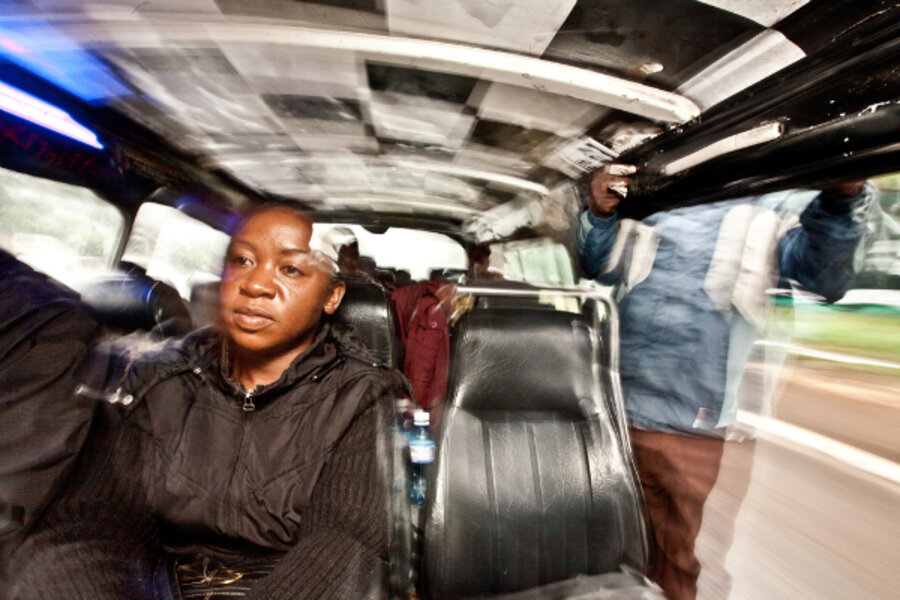Life in Nairobi, as seen from the windows of its minibuses
Loading...
| Kawangware, Nairobi, Kenya
It’s already past 7:15 a.m. and Catherine, a 32-year-old civil servant, knows she’ll be late for work.
It’s less than 2.5 miles from the Petro gas station, the start of the Route 46 bus near her home in Kawangware, to her Upper Hill office just west of the city centre.
But that will take Catherine at least an hour this morning, as steady sheets of dawn rain fell and traffic crawled along the slum’s choked streets.
“The rain, it always delays everyone, the jams will be bad today,” she says, flapping her umbrella dry as she squeezes into our 14-seater Nissan minibus with a black interior and a roof lined in checker-board linoleum. She flips open her Motorola cell to hook to the internet to pass the time.
Up front, at the wheel and in charge of getting Catherine to work as quickly as possible, rain or no rain, is Emmanuel Sinzole. For ten years, he’s been driving matatus, as these buses are called in Kenya’s Kiswahili language.
“When there’s too much traffic you don’t make money, sometimes you work the whole day and go home with nothing,” he says, nudging the Nissan forward a foot.
“But I like it. I like the challenge, I like to be happy as we drive so the passengers are happy.”
7:48 a.m.
The matatu, its hood branded Classic Reebok, its trunk bearing the puzzling epithet No Man Should Eat Man Society, has edged barely a mile down Gitanga Road.
We’re out of Kawangware now, leaving behind its muddy lanes and rusting tin roofs, its streetside carpenters and hole-in-the-wall tea shacks.
Here, through the fogged windows, another gas station, but with a pizzeria and ice cream parlor. Beside it, a luxury car dealer whose yard is stocked with rain-polished Mercedes, Jeeps, BMWs and Japanese SUVs.
Ahead, a line of traffic climbs a hill. Seeing his chance, Emmanuel swerves out and speeds up the opposite lane, jumping a dozen cars before the flashing headlights of an oncoming bus force him back in.
“You have to be faster, to get people to work, to get yourself some money,” he smiles. “That’s why you see us being a bit rough, obstructing, maybe bending rules.”
The maneuver, which draws ire from other drivers, prompts a giggle from Catherine.
“This is why we are better off in the matatus, we get to work quicker than them,” she says, looking out at a shining late-model Toyota sedan we leave behind as Emmanuel lurches us forward another half-dozen spaces.
I ask Catherine how things are changing in her city. She gestures to a new-built three-storey block of apartments.
“Construction, everywhere,” she says. “All of these plots were just small houses before, now they are so many apartments selling for $150,000, $200,000. How can anyone afford something like that?”
Despite her salaried job at Kenya’s Energy Regulatory Commission, the bank loans flowing to the country’s mushrooming middle class are – for now – beyond her reach.
There’s no bitterness or envy, however, as she talks of wanting to upgrade from the home she shares with her two children in Kawangware.
“Obviously it’s not satisfactory, but there are others who are languishing in poverty, some people have jobs, some have no jobs,” she says.
“We can’t live a standard life, we are living various lives, some are rich, some are poor, it depends. Things are not so bad for me,” she says.
8:07 a.m.
A mile closer to town. Solomon Waithaka, the matatu’s conductor, is as sanguine as Catherine. Sliding open the door for alighting passengers in Hurlingham, opposite the Russian-run casino, he states: “I like my job, yes.”
There’s a pause. “But you know it’s just for money. Let me tell you, if I get another job, a good one, I will leave this one,” he says. He’s been riding the matatus, taking fares, touting for passengers, for 15 years.
No other good job has come his way, yet.
8:11 a.m.
Three more gas stations: gas at $4.36 a gallon, diesel $3.93 a gallon. A billboard for Kenya’s Tusker beer, boasting “100% African inspiration”.
The traffic thins. Solomon smiles as Emmanuel speeds up. Catherine packs away her Motorola, counts change for her fare.
We beat the lights and turn towards Upper Hill, home to government offices, insurance firms and banks. Nairobi’s downtown district stretches off to our left, beyond Uhuru Park and All Saints Cathedral with its imported Scottish stained-glass windows.
8:14 a.m.
Catherine’s stop. She smiles as she steps down from the matatu, shouts “nice day” over her shoulder as she hurries up the hill to her day of training. If the rain holds, she’ll be at least another hour getting home to her kids tonight.
For Emmanuel and Solomon, it’s speed that counts now, as the roads clear towards Railways, the town-side end of the Route 46.
The quicker they get to town, the quicker they can load up and head back out. Together, the pair have to pay the matatu’s owner something close to $50 a day to rent the minibus, and they must pay for gas themselves.
Anything on top is their profit. But our fare for the hour’s journey, even at peak-time premium, was less than $1. Heading the other way, it’s half that.
We splash through puddles into the terminus, by the city’s iconic Railway Station. As the last two passengers spill out, Emmanuel swings the Nissan round, hoots a good-bye, and is gone, back into the bustle, back to the hustle.
This post is part of the Daily Dispatch project chronicling life in Nairobi, Kenya throughout the month of April.





